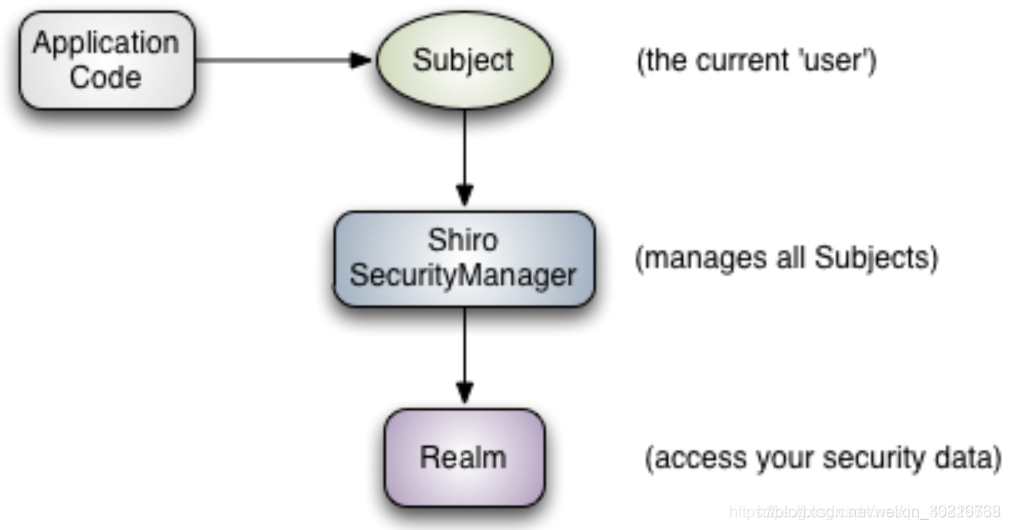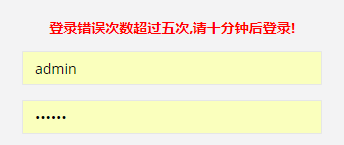文章目录
- 二、Controller层接收登录请求
- 三、自定义的Realm
- 四、密码验证器增加登录次数校验功能
- 五、ShiroConfig的配置类
- 六、EhCache 的配置
- 七、全局异常的配置
####### 一、 Shiro的执行流程

1、核心介绍
1)Application Code用户编写代码
2)Subject就是shiro管理的用户
3)SecurityManager安全管理器,就是shiro权限控制核心对象,在编程时,只需要操作Subject方法,底层调用SecurityManager方法,无需直接编程操作SecurityManager
4)Realm应用程序和安全数据之间连接器,应用程序进行权限控制读取安全数据(数据表、文件、网络…)通过Realm对象完成
2、Shiro执行流程
应用程序(就是你自己的项目)—>Subject—>SecurityManager—>Realm—>安全数据
3、Shiro进行权限控制的四种主要方式
1)在程序中通过Subject编程方式进行权限控制
2)配置Filter实现URL级别粗粒度权限控制
3)配置代理,基于注解实现细粒度权限控制
4)在页面中使用shiro自定义标签实现,页面显示权限控制
Shiro执行登录的流程如下图.

大致的思路如下, 在Controller层接收前端输入的用户名和密码. 调用Shiro的SecurityUtils.getSubject()方法获取Subject对象.
之后用Subject对象调用login方法,其Shiro底层会进行密码的验证, 传入UsernamePasswordToken对象,此对象封装了前端传入的用户名和密码.

接着Shiro的SecurityManager会去调用自定义的Realm的AuthenticationInfo方法进行登录的验证, 此方法会返回一个SimpleAuthenticationInfo对象,此对象封装了ShiroUser ,数据库中存储的当前用户的密码, 密码加盐的值,Realm的名称, 即把数据库中的当前的用户, 与用户输入的用户名密码即存储在 UsernamePasswordToken进行比较,如果密码正确,登录成功,密码不正确登录失败.


调用自定义Realm的AuthenticationInfo完了之后, 调用RetryLimitCredentialsMatcher类中的doCredentialsMatch方法, 进行密码匹配次数的记录. 并用EhCache作为缓存, 把当前登录的用户名作为key,key的过期时间按照需求设置即可, 把登录的次数作为值.首先通过用户名,获取登录次数,如果登录次数为0, 那么先给当前用户设置一个缓存,登录次数+1,之后判断是否大于限定的登录错误次数,如果超过了限定次数,则抛出异常,用全局的异常拦截器,拦截此异常, 记录登录错误次数的异常, 并封装登录次数过多的提示,给客户端. 具体的代码在下面.
二、Controller层接收登录请求
Shiro的工具类ShiroKit
import org.apache.shiro.SecurityUtils;
import org.apache.shiro.crypto.hash.Md5Hash;
import org.apache.shiro.crypto.hash.SimpleHash;
import org.apache.shiro.session.Session;
import org.apache.shiro.subject.Subject;
import org.apache.shiro.util.ByteSource;import java.util.List;/*** shiro工具类***/
public class ShiroKit {/*** 名称分隔符*/private static final String NAMES_DELIMETER = ",";/*** 加盐参数*/public final static String HASH_ALGORITHM_NAME = "MD5";/*** 循环次数*/public final static int HASHITERATIONS = 1024;/*** 验证是否同一个账号重新登录的属性,为true代表是重新登录, 初始化为false,代表不是重新登录*/public static boolean ISPEATEDLOGIN =false;/*** shiro密码加密工具类** @param credentials 密码* @param saltSource 密码盐* @return*/public static String md5(String credentials, String saltSource) {ByteSource salt = new Md5Hash(saltSource);return new SimpleHash(HASH_ALGORITHM_NAME, credentials, salt, HASHITERATIONS).toString();}/*** 获取随机盐值** @param length* @return*/public static String getRandomSalt(int length) {return ToolUtil.getRandomString(length);}/*** 获取当前 Subject.* Subject表示单个应用程序用户的状态和安全操作。* 这些操作包括身份验证(登录/注销),授权(访问控制)和会话访问。* 这是Shiro的单用户安全功能的主要机制。** @return Subject*/public static Subject getSubject() {return SecurityUtils.getSubject();}/*** 获取封装的 ShiroUser** @return ShiroUser*/public static ShiroUser getUser() {if (isGuest()) {return null;} else {return (ShiroUser) getSubject().getPrincipals().getPrimaryPrincipal();}}/*** 从shiro获取session*/public static Session getSession() {return getSubject().getSession();}/*** 获取shiro指定的sessionKey*/@SuppressWarnings("unchecked")public static <T> T getSessionAttr(String key) {Session session = getSession();return session != null ? (T) session.getAttribute(key) : null;}/*** 设置shiro指定的sessionKey*/public static void setSessionAttr(String key, Object value) {Session session = getSession();session.setAttribute(key, value);}/*** 移除shiro指定的sessionKey*/public static void removeSessionAttr(String key) {Session session = getSession();if (session != null)session.removeAttribute(key);}/*** 验证当前用户是否属于该角色?,使用时与lacksRole 搭配使用** @param roleName 角色名* @return 属于该角色:true,否则false*/public static boolean hasRole(String roleName) {return getSubject() != null && roleName != null&& roleName.length() > 0 && getSubject().hasRole(roleName);}/*** 与hasRole标签逻辑相反,当用户不属于该角色时验证通过。** @param roleName 角色名* @return 不属于该角色:true,否则false*/public static boolean lacksRole(String roleName) {return !hasRole(roleName);}/*** 验证当前用户是否属于以下任意一个角色。** @param roleNames 角色列表* @return 属于:true,否则false*/public static boolean hasAnyRoles(String roleNames) {boolean hasAnyRole = false;Subject subject = getSubject();if (subject != null && roleNames != null && roleNames.length() > 0) {for (String role : roleNames.split(NAMES_DELIMETER)) {if (subject.hasRole(role.trim())) {hasAnyRole = true;break;}}}return hasAnyRole;}/*** 验证当前用户是否属于以下所有角色。** @param roleNames 角色列表* @return 属于:true,否则false*/public static boolean hasAllRoles(String roleNames) {boolean hasAllRole = true;Subject subject = getSubject();if (subject != null && roleNames != null && roleNames.length() > 0) {for (String role : roleNames.split(NAMES_DELIMETER)) {if (!subject.hasRole(role.trim())) {hasAllRole = false;break;}}}return hasAllRole;}/*** 验证当前用户是否拥有指定权限,使用时与lacksPermission 搭配使用** @param permission 权限名* @return 拥有权限:true,否则false*/public static boolean hasPermission(String permission) {return getSubject() != null && permission != null&& permission.length() > 0&& getSubject().isPermitted(permission);}/*** 与hasPermission标签逻辑相反,当前用户没有制定权限时,验证通过。** @param permission 权限名* @return 拥有权限:true,否则false*/public static boolean lacksPermission(String permission) {return !hasPermission(permission);}/*** 已认证通过的用户。不包含已记住的用户,这是与user标签的区别所在。与notAuthenticated搭配使用** @return 通过身份验证:true,否则false*/public static boolean isAuthenticated() {return getSubject() != null && getSubject().isAuthenticated();}/*** 未认证通过用户,与authenticated标签相对应。与guest标签的区别是,该标签包含已记住用户。。** @return 没有通过身份验证:true,否则false*/public static boolean notAuthenticated() {return !isAuthenticated();}/*** 认证通过或已记住的用户。与guset搭配使用。** @return 用户:true,否则 false*/public static boolean isUser() {return getSubject() != null && getSubject().getPrincipal() != null;}/*** 验证当前用户是否为“访客”,即未认证(包含未记住)的用户。用user搭配使用** @return 访客:true,否则false*/public static boolean isGuest() {return !isUser();}/*** 输出当前用户信息,通常为登录帐号信息。** @return 当前用户信息*/public static String principal() {if (getSubject() != null) {Object principal = getSubject().getPrincipal();return principal.toString();}return "";}}
三、自定义的Realm
import cn.stylefeng.roses.core.util.HttpContext;
import cn.stylefeng.roses.core.util.ToolUtil;
import cn.utry.govaffairs.core.shiro.service.UserAuthService;
import cn.utry.govaffairs.core.shiro.service.impl.UserAuthServiceServiceImpl;
import cn.utry.govaffairs.modular.system.model.User;
import org.apache.shiro.SecurityUtils;
import org.apache.shiro.authc.AuthenticationException;
import org.apache.shiro.authc.AuthenticationInfo;
import org.apache.shiro.authc.AuthenticationToken;
import org.apache.shiro.authc.UsernamePasswordToken;
import org.apache.shiro.authc.credential.CredentialsMatcher;
import org.apache.shiro.authc.credential.HashedCredentialsMatcher;
import org.apache.shiro.authz.AuthorizationInfo;
import org.apache.shiro.authz.SimpleAuthorizationInfo;
import org.apache.shiro.realm.AuthorizingRealm;
import org.apache.shiro.session.Session;
import org.apache.shiro.session.mgt.eis.SessionDAO;
import org.apache.shiro.subject.PrincipalCollection;
import org.springframework.beans.factory.annotation.Autowired;import javax.servlet.http.HttpServletRequest;
import javax.servlet.http.HttpServletResponse;
import java.io.IOException;
import java.util.Collection;
import java.util.HashSet;
import java.util.List;
import java.util.Set;public class ShiroDbRealm extends AuthorizingRealm {@Autowiredprivate SessionDAO sessionDAO;/*** 登录认证 证明 鉴定*/@Overrideprotected AuthenticationInfo doGetAuthenticationInfo(AuthenticationToken authcToken)throws AuthenticationException {// 获取shirorealm所需数据的Service层UserAuthService shiroFactory = UserAuthServiceServiceImpl.me();//获取Controller层传递的token,包含了前端输入的用户名和密码 一个简单的用户名/密码身份验证令牌UsernamePasswordToken token = (UsernamePasswordToken) authcToken;//获取登录的用户名String username = token.getUsername();//根据前端输入的账号, 去数据库查询用户信息. 此时如果账号不存在(包括逻辑删除)或被冻结,直接抛出异常,终止登录User user = shiroFactory.user(token.getUsername());//进行用户的验证ShiroUser shiroUser = shiroFactory.shiroUser(user);// 获取需要登录的用户在数据库中存储的加盐的密码String credentials = user.getPassword();// 获取需要登录的用户在数据库中存储的密码的盐值String source = user.getSalt();ByteSource credentialsSalt = new Md5Hash(source);// 创建SimpleAuthenticationInfo 返回给shiro的安全管理器去比较当前登录用户输入的密码,与数据库中存储的加盐的密码是否一致// 即在登录的Controller层 UsernamePasswordToken 中存储了当前输入的用户名与密码, 与此SimpleAuthenticationInfo 进行比较// 如果密码一致,代表登录成功, 密码不一致,则报密码错误的异常return new SimpleAuthenticationInfo(shiroUser, credentials, credentialsSalt, realmName);}/*** 权限认证 授权,认可*/@Overrideprotected AuthorizationInfo doGetAuthorizationInfo(PrincipalCollection principals) {return null;}四、密码验证器增加登录次数校验功能
import org.apache.shiro.authc.AuthenticationInfo;
import org.apache.shiro.authc.AuthenticationToken;
import org.apache.shiro.authc.ExcessiveAttemptsException;
import org.apache.shiro.authc.credential.HashedCredentialsMatcher;
import org.apache.shiro.cache.Cache;
import org.apache.shiro.cache.CacheManager;
import org.slf4j.Logger;
import org.slf4j.LoggerFactory;
import org.springframework.beans.factory.annotation.Value;
import org.springframework.stereotype.Component;import java.util.Set;
import java.util.concurrent.atomic.AtomicInteger;/*** 验证器,增加了登录次数校验功能*/public class RetryLimitCredentialsMatcher extends HashedCredentialsMatcher {/*** 密码输入错误次数就被冻结*/private Integer errorPasswordTimes=5;private Cache<String, AtomicInteger> passwordRetryCache;/*** 构造方法 创建对象,传入缓存的管理器* @param cacheManager*/public RetryLimitCredentialsMatcher(CacheManager cacheManager) {passwordRetryCache = cacheManager.getCache("passwordRetryCache");}/*** 方法名: doCredentialsMatch* 方法描述: 用户登录错误次数方法.* 修改日期: 2019/2/26 20:19* @param token* @param info* @return boolean* @throws*/@Overridepublic boolean doCredentialsMatch(AuthenticationToken token,AuthenticationInfo info) {String username = (String) token.getPrincipal();Set<String> keys = passwordRetryCache.keys();// retry count + 1AtomicInteger retryCount = passwordRetryCache.get(username);if (retryCount == null) {retryCount = new AtomicInteger(0);passwordRetryCache.put(username, retryCount);}if (retryCount.incrementAndGet() > errorPasswordTimes) {// if retry count > 5 throwthrow new ExcessiveAttemptsException();}boolean matches = super.doCredentialsMatch(token, info);if (matches) {// clear retry countpasswordRetryCache.remove(username);}return matches;}
}五、ShiroConfig的配置类
在此配置类中, 要注意的是把ShiroDbRealm的bean中要调用set方法注入retryLimitCredentialsMatcher,否则密码错误次数的校验不会生效.
@Configuration
public class ShiroConfig {/*** Shiro生命周期处理器:* 用于在实现了Initializable接口的Shiro bean初始化时调用Initializable接口回调(例如:UserRealm)* 在实现了Destroyable接口的Shiro bean销毁时调用 Destroyable接口回调(例如:DefaultSecurityManager)*/@Beanpublic LifecycleBeanPostProcessor lifecycleBeanPostProcessor() {return new LifecycleBeanPostProcessor();}/*** 方法名: getDefaultAdvisorAutoProxyCreator* 方法描述: 开启Shiro的注解模式* 修改日期: 2019/2/25 16:03* @param* @return org.springframework.aop.framework.autoproxy.DefaultAdvisorAutoProxyCreator* @author taohongchao* @throws*/@Beanpublic DefaultAdvisorAutoProxyCreator getDefaultAdvisorAutoProxyCreator() {DefaultAdvisorAutoProxyCreator autoProxyCreator = new DefaultAdvisorAutoProxyCreator();autoProxyCreator.setProxyTargetClass(true);return autoProxyCreator;}/*** 安全管理器*/@Beanpublic DefaultWebSecurityManager securityManager(CookieRememberMeManager rememberMeManager,CacheManager cacheShiroManager,SessionManager sessionManager,RetryLimitCredentialsMatcher retryLimitCredentialsMatcher) {DefaultWebSecurityManager securityManager = new DefaultWebSecurityManager();//把自定义的Realm注入安全管理器中securityManager.setRealm(this.shiroDbRealm(retryLimitCredentialsMatcher));securityManager.setCacheManager(cacheShiroManager);securityManager.setRememberMeManager(rememberMeManager);securityManager.setSessionManager(sessionManager);return securityManager;}/*** 缓存管理器 使用Ehcache实现*/@Beanpublic CacheManager getCacheShiroManager(EhCacheManagerFactoryBean ehcache) {EhCacheManager ehCacheManager = new EhCacheManager();ehCacheManager.setCacheManager(ehcache.getObject());ehCacheManager.setCacheManagerConfigFile("ehcache.xml");return ehCacheManager;}@Beanpublic RetryLimitCredentialsMatcher getRetryLimit(CacheManager cacheManager){RetryLimitCredentialsMatcher retryLimitCredentialsMatcher = new RetryLimitCredentialsMatcher(cacheManager);retryLimitCredentialsMatcher.setHashAlgorithmName(ShiroKit.HASH_ALGORITHM_NAME);retryLimitCredentialsMatcher.setHashIterations(ShiroKit.HASHITERATIONS);retryLimitCredentialsMatcher.setStoredCredentialsHexEncoded(true);return retryLimitCredentialsMatcher;}/*** 项目自定义的Realm*/@Beanpublic ShiroDbRealm shiroDbRealm(RetryLimitCredentialsMatcher retryLimitCredentialsMatcher) {ShiroDbRealm shiroDbRealm = new ShiroDbRealm();shiroDbRealm.setCredentialsMatcher(retryLimitCredentialsMatcher);return shiroDbRealm;}
}六、EhCache 的配置
EhCache.xml中的配置, 其中设置了名称为passwordRetryCache的缓存,用于冻结密码输入错误次数多过的缓存.
<?xml version="1.0" encoding="UTF-8"?>
<ehcache xmlns:xsi="http://www.w3.org/2001/XMLSchema-instance"xsi:noNamespaceSchemaLocation="ehcache.xsd"updateCheck="false" monitoring="autodetect"dynamicConfig="true" ><diskStore path="java.io.tmpdir/ehcache"/><defaultCachemaxElementsInMemory="50000"eternal="false"timeToIdleSeconds="3600"timeToLiveSeconds="3600"overflowToDisk="true"diskPersistent="false"diskExpiryThreadIntervalSeconds="120"/><!-- 登录记录缓存 锁定10分钟 --><cache name="passwordRetryCache"eternal="false"timeToIdleSeconds="600"timeToLiveSeconds="0"overflowToDisk="false"statistics="true"maxEntriesLocalHeap="0"></cache></ehcache>EhCacheConfig的配置类
import net.sf.ehcache.CacheManager;
import org.springframework.cache.annotation.EnableCaching;
import org.springframework.cache.ehcache.EhCacheCacheManager;
import org.springframework.cache.ehcache.EhCacheManagerFactoryBean;
import org.springframework.context.annotation.Bean;
import org.springframework.context.annotation.Configuration;
import org.springframework.core.io.ClassPathResource;/*** ehcache配置** @author* @date 2017-05-20 23:11*/
@Configuration
@EnableCaching
public class EhCacheConfig {/*** EhCache的配置*/@Beanpublic EhCacheCacheManager cacheManager(CacheManager cacheManager) {return new EhCacheCacheManager(cacheManager);}/*** EhCache的配置*/@Beanpublic EhCacheManagerFactoryBean ehcache() {EhCacheManagerFactoryBean ehCacheManagerFactoryBean = new EhCacheManagerFactoryBean();ehCacheManagerFactoryBean.setConfigLocation(new ClassPathResource("ehcache.xml"));return ehCacheManagerFactoryBean;}
}七、全局异常的配置
当密码输入错误次数过多时,抛出ExcessiveAttemptsException异常,被此异常拦截器拦截
@ControllerAdvice
@Order(-1)
public class GlobalExceptionHandler {/*** 方法名: excessiveAttemptsException* 方法描述: 登录错误次数过多异常 * @throws*/@ExceptionHandler(ExcessiveAttemptsException.class)@ResponseStatus(HttpStatus.UNAUTHORIZED)public String excessiveAttemptsException(ExcessiveAttemptsException e, Model model) {String username = getRequest().getParameter("username");LogManager.me().executeLog(LogTaskFactory.loginLog(username, "登录错误次数超过五次", getIp()));model.addAttribute("tips", "登录错误次数超过五次,请十分钟后登录!");return "/login.html";}
}最终的效果如图所示











)
)
,找到树中第K小的节点)






